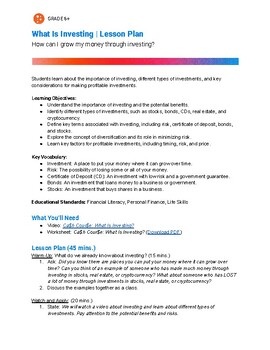Financial Literacy: What is Investing? - Lesson Plan & Video Link
146 Downloads
PragerU Kids
144 Followers
Grade Levels
6th - 12th
Subjects
Resource Type
Standards
CCSSW.8.1
CCSSW.9-10.1
CCSSW.11-12.1
CCSSMP2
CCSSMP3
Formats Included
- PDF
Pages
4 pages
PragerU Kids
144 Followers
Description
This lesson plan and worksheet teach middle and high school students the importance of investing, different types of investments, and key considerations for profitable investments. Cash Course is an entertaining and educational PragerU show highlighting the importance of money management and financial literacy for grades 6+. Use the Cash Course lesson plan, worksheet, and companion video to explore various kinds of investment possibilities as well as the potential risks involved. The Cash Course video links and a printable worksheet are embedded for easy access.
Total Pages
4 pages
Answer Key
Included
Teaching Duration
45 minutes
Last updated 4 months ago
Report this resource to TPT
Reported resources will be reviewed by our team. Report this resource to let us know if this resource violates TPT’s content guidelines.
Standards
to see state-specific standards (only available in the US).
CCSSW.8.1
Write arguments to support claims with clear reasons and relevant evidence.
CCSSW.9-10.1
Write arguments to support claims in an analysis of substantive topics or texts, using valid reasoning and relevant and sufficient evidence.
CCSSW.11-12.1
Write arguments to support claims in an analysis of substantive topics or texts, using valid reasoning and relevant and sufficient evidence.
CCSSMP2
Reason abstractly and quantitatively. Mathematically proficient students make sense of quantities and their relationships in problem situations. They bring two complementary abilities to bear on problems involving quantitative relationships: the ability to decontextualize-to abstract a given situation and represent it symbolically and manipulate the representing symbols as if they have a life of their own, without necessarily attending to their referents-and the ability to contextualize, to pause as needed during the manipulation process in order to probe into the referents for the symbols involved. Quantitative reasoning entails habits of creating a coherent representation of the problem at hand; considering the units involved; attending to the meaning of quantities, not just how to compute them; and knowing and flexibly using different properties of operations and objects.
CCSSMP3
Construct viable arguments and critique the reasoning of others. Mathematically proficient students understand and use stated assumptions, definitions, and previously established results in constructing arguments. They make conjectures and build a logical progression of statements to explore the truth of their conjectures. They are able to analyze situations by breaking them into cases, and can recognize and use counterexamples. They justify their conclusions, communicate them to others, and respond to the arguments of others. They reason inductively about data, making plausible arguments that take into account the context from which the data arose. Mathematically proficient students are also able to compare the effectiveness of two plausible arguments, distinguish correct logic or reasoning from that which is flawed, and-if there is a flaw in an argument-explain what it is. Elementary students can construct arguments using concrete referents such as objects, drawings, diagrams, and actions. Such arguments can make sense and be correct, even though they are not generalized or made formal until later grades. Later, students learn to determine domains to which an argument applies. Students at all grades can listen or read the arguments of others, decide whether they make sense, and ask useful questions to clarify or improve the arguments.





